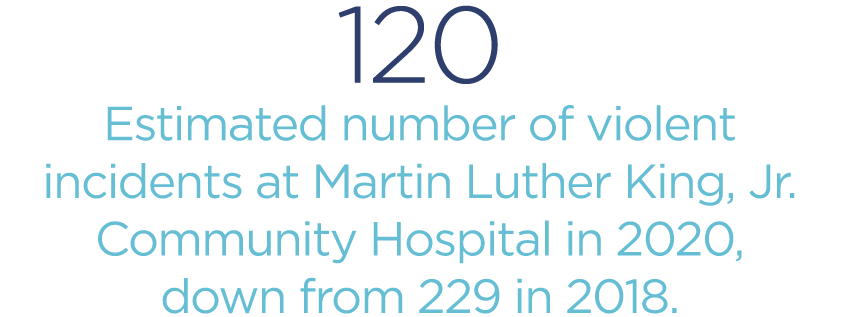Audio and Acumen Against Aggression
As many people experienced firsthand, the past year featured incredible stressors on people and institutions alike—including hospitals.
Resources were tight at the Martin Luther King, Jr. Community Hospital before 2020 and the COVID-19 pandemic. Due to a surge of patients in recent years, administrators and healthcare providers have been forced to find new ways to treat people in a limited space while keeping 2,000 employees, staff, and contractors safe.
Located in Willowbrook, California, the 131-bed hospital has the second-busiest emergency department in Los Angeles County and, according to an inpatient census, it regularly operates at 95 to 105 percent capacity. When patients began to outnumber hospital beds, the clinical staff and ancillary services departments worked together to generate creative solutions, including pop-up tents that allowed doctors and nurses to treat the overflow of people at this facility—a tactic that was also used in treating COVID-19 patients.
Many patients are from lower socioeconomic areas of Los Angeles and are either uninsured or on some form of government-funded insurance, such as Medicaid. To better serve the community, Mark Reed, director of the hospital’s support services, and Jonathan Westall, vice president of ancillary services, maintain that a security program that supports facility personnel will ultimately benefit all.
Keeping the larger picture in mind is key for the facility as it works to overcome the shadow of its predecessor, government hospital Martin Luther King, Jr. Outpatient Center, which was closed in 2007 after years of deficient patient care. Additionally, Reed and Westall say they hoped that improved security would attract and retain talented healthcare professionals to the facility, which is in a high-crime area.

“There’s some stigma to overcome here,” Westall says, especially when competing with hospitals in nearby high-income suburbs like Pasadena. Westall and Reed note that healthcare providers are already more likely to encounter workplace violence compared to personnel in other industries, and that working in higher-crime regions further amplifies that probability.
“We might have a shooting in the neighborhood every 10 years, but we have aggression here daily,” Reed says. And it’s the aggression that Reed and Westall want to be alerted to before it can escalate.
Before December 2019, the hospital’s security technology primarily consisted of roughly 100 cameras and an Axis Communications control system with a proximity reader. Over the past two years, MLK Community Hospital invested in systems that address signs of aggression.
“I think we have to go above and beyond, especially around security presence and posture to make people feel safer so they want to come to work here,” Westall says. “You don’t want to go to work and get punched in the mouth—unless you’re a boxer, maybe.”
To further reduce the number of violent incidents at the hospital, security decided to implement Sound Intelligence—an audio aggression and gunshot detector from Axis—onto its existing cameras in emergency areas, the front lobby, and the cafeteria in December 2019. “It really gave us some awareness when it came to aggression detection, as well as shooter detection,” Reed adds.
Beyond providing the hospital’s security staff with immediate awareness of an active shooter, the detector also delivers real-time information about aggressive interactions. Sound Intelligence was integrated with the hospital’s Genetec video management system to highlight the cameras that are picking up on signs of aggression. When triggered by aggression indicators—volume, inflection, and tonal indicators—the system issues a digital alert and brings up the camera’s view for video operators, giving the hospital’s security team more information on the cause of the aggression and more lead time to plan and respond appropriately than they would have if waiting for someone to report an incident.
Before using the aggression detection system, notifications would take longer—potentially only being sent after aggression had already had a chance to escalate into violence, Reed adds. “Now it’s immediate.... It really reduces that time. I think it’s reduced some of our incidents.”
The sound detectors were installed in December 2019 during a two-week calibration window that Reed describes as “pretty seamless.” Although some of the older cameras needed to be replaced, the process was both quick and cost-efficient for the hospital because there was no need for rewiring or a more invasive installation.
“We see a lot of mental health patients here…so there are quite a few times throughout the day we get an aggression detection in the emergency room,” Reed says. With an alert from the camera’s sound detector, security can identify the source of a patient’s frustration and dispatch the nearest public safety officer to intervene and de-escalate the situation, allowing staff to be more proactive instead of solely reactive.
With the aid of technology, Reed says the number of violent incidents at the hospital has decreased year-over-year—with 229 in 2018, 151 in 2019, and an estimated 120 for 2020.
Another benefit to the decrease in escalation is that worker compensation claims are down, as are lost time and injury rates among staff, while retention has increased, according to Reed.
“Nurses are in demand; they can work just about anywhere,” Reed notes, especially given the additional strain on the healthcare industry created by the COVID-19 pandemic. “The fact that they want to work somewhere where it’s safe, that helps our retention rates. That’s a lot of HR dollars that we’re not spending.”
To continue improving the hospital’s overall safety program and making sure that tools and technology like Sound Intelligence are placed where they are needed, Reed emphasizes to staff to continue reporting every single event.
“That’s where we get our data that we use to make informed decisions, and we’re making improvements on our program,” he says. “Instead of just throwing officers at the problem, we’re using technology.”
Reed adds that the hospital plans to build community clinics and outpatient centers because the area lacks doctors’ offices where residents can make general appointments, create a relationship with a primary care physician, or receive treatment for preventable illnesses.
“We’re trying to really give them the opportunity to address these concerns before it comes to the point they need a higher level of care than a hospital,” Reed says.
And as the hospital expands its presence in the community, it plans to also widen its use of the sound detection platform to future clinics and centers.
For more information about Sound Intelligence, email [email protected].
